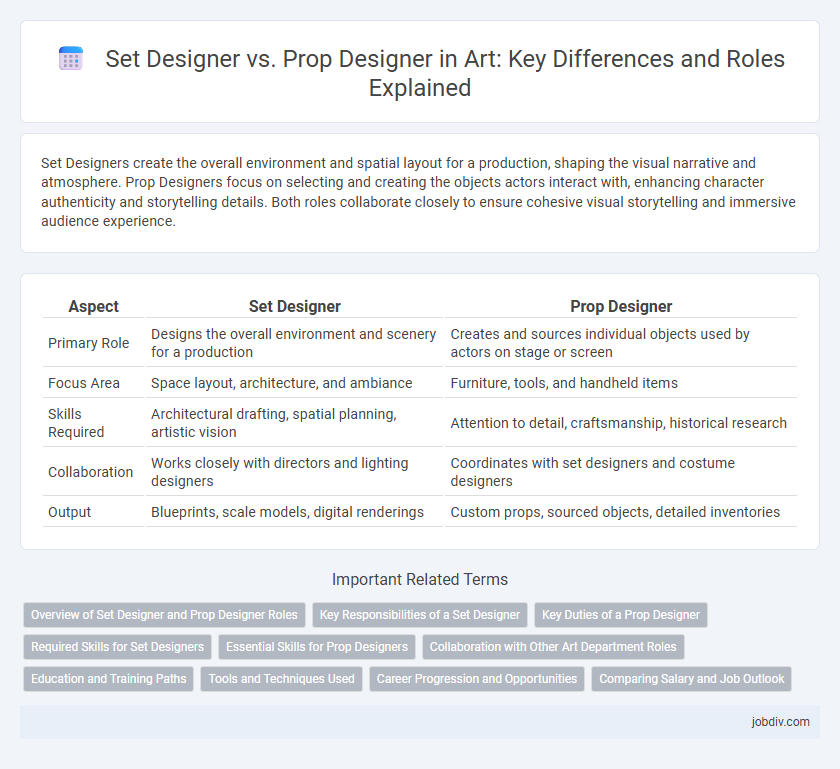Set Designers create the overall environment and spatial layout for a production, shaping the visual narrative and atmosphere. Prop Designers focus on selecting and creating the objects actors interact with, enhancing character authenticity and storytelling details. Both roles collaborate closely to ensure cohesive visual storytelling and immersive audience experience.
Table of Comparison
| Aspect | Set Designer | Prop Designer |
|---|---|---|
| Primary Role | Designs the overall environment and scenery for a production | Creates and sources individual objects used by actors on stage or screen |
| Focus Area | Space layout, architecture, and ambiance | Furniture, tools, and handheld items |
| Skills Required | Architectural drafting, spatial planning, artistic vision | Attention to detail, craftsmanship, historical research |
| Collaboration | Works closely with directors and lighting designers | Coordinates with set designers and costume designers |
| Output | Blueprints, scale models, digital renderings | Custom props, sourced objects, detailed inventories |
Overview of Set Designer and Prop Designer Roles
Set designers focus on designing and creating the physical environment of a performance, including backgrounds, scenery, and structural elements that establish the setting and mood. Prop designers specialize in crafting and sourcing objects that actors interact with, ensuring these items support the story and enhance realism. Both roles collaborate closely with directors and production teams to create a cohesive visual experience on stage or screen.
Key Responsibilities of a Set Designer
Set designers create the overall visual environment of a production, designing the structural elements like walls, platforms, and large scenic pieces to establish the setting and mood. They collaborate closely with directors and lighting designers to ensure the physical space supports the storytelling and actor movement. Their key responsibilities include drafting detailed plans, selecting materials, and supervising the construction of the set to achieve both aesthetic and functional goals.
Key Duties of a Prop Designer
A Prop Designer is responsible for creating, sourcing, and maintaining all hand-held objects and small-scale items used by actors to enhance storytelling on stage or screen. They collaborate closely with directors and set designers to ensure props align with the production's aesthetic and period accuracy. Their key duties include designing custom props, managing budgets and timelines, and coordinating with fabrication teams to achieve functional and visually cohesive elements.
Required Skills for Set Designers
Set designers require strong skills in spatial awareness, architectural drawing, and creative visualization to construct immersive environments that support the narrative. Proficiency in digital design software like AutoCAD, SketchUp, and Adobe Creative Suite is essential for translating concepts into detailed plans and models. Knowledge of materials, lighting, and construction techniques enables set designers to collaborate effectively with directors, prop designers, and builders, ensuring functional and aesthetically cohesive stage settings.
Essential Skills for Prop Designers
Prop designers require a deep understanding of materials, craftsmanship, and historical accuracy to create functional and visually compelling objects that enhance storytelling. Essential skills include proficiency in carpentry, painting, and sculpting, alongside a keen eye for detail and the ability to collaborate closely with directors and set designers. Mastery of these skills ensures props are safe, practical, and seamlessly integrated into the overall production design.
Collaboration with Other Art Department Roles
Set designers and prop designers collaborate closely with costume designers and lighting technicians to ensure a cohesive visual narrative on stage or screen. Set designers create the overall environment, integrating spatial elements that support the director's vision, while prop designers focus on detailed objects that actors interact with, enhancing storytelling authenticity. Their teamwork with art directors and production designers ensures that every artistic element aligns harmoniously within the production's aesthetic and functional requirements.
Education and Training Paths
Set designers typically pursue formal education in theater design, architecture, or fine arts, with many obtaining bachelor's or master's degrees in scenography or stage design to develop skills in spatial planning and visual storytelling. Prop designers often train through specialized courses in prop making, sculpture, or industrial design, combining hands-on workshops and apprenticeships to master materials, fabrication techniques, and historical research. Both career paths benefit from internships and practical experience on productions, but set designers emphasize comprehensive design principles, while prop designers focus on craftsmanship and functionality.
Tools and Techniques Used
Set designers utilize drafting software such as AutoCAD and SketchUp to create detailed, scalable blueprints of stage environments, while also applying traditional model-making techniques to visualize spatial arrangements. Prop designers focus on crafting individual items using sculpting tools, 3D printers, and materials like foam, resin, and metal to ensure functionality and authenticity for actors' use. Both roles integrate digital imaging software like Adobe Photoshop to refine textures and colors, enhancing the overall visual coherence of theatrical productions.
Career Progression and Opportunities
Set designers often advance by developing expertise in spatial planning, lighting, and structural design, leading to roles such as art director or production designer in theater, film, and television. Prop designers specialize in crafting and sourcing objects that enhance storytelling, progressing to senior prop master or prop supervisor positions with opportunities to work on major productions and commercials. Both career paths offer growth through collaboration with directors and designers, expanding creative influence and networking within the entertainment industry.
Comparing Salary and Job Outlook
Set designers typically earn a median salary ranging from $50,000 to $70,000 annually, while prop designers average slightly lower, around $40,000 to $60,000. The job outlook for set designers shows a steady growth rate of 4% due to ongoing demand in theater, film, and television productions, whereas prop designers experience a similar growth trajectory but may face more freelance and contract-based opportunities. Both roles require strong creative skills, though set designers often benefit from larger-scale project budgets impacting their earning potential and job stability.
Set Designer vs Prop Designer Infographic

 jobdiv.com
jobdiv.com